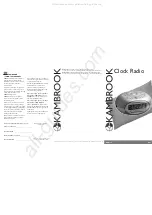Low EMI Spectrum Spread Clock
FS781/82/84
Cypress Semiconductor Corporation
•
198 Champion Court
•
San Jose
,
CA 95134-1709
•
408-943-2600
Document #: 38-07029 Rev. *F
Revised January 2, 2005
Features
• Spread Spectrum clock generator (SSCG) with 1×, 2×,
and 4× outputs
• 6- to 82-MHz operating frequency range
• Modulates external clocks including crystals, crystal
oscillators, or ceramic resonators
• Programmable modulation with simple R-C external
loop filter (LF)
• Center spread modulation
• 3V-5V power supply
• TTL-/CMOS-compatible outputs
• Low short-term jitter
• Low-power Dissipation
— 3.3 VDC = 37 mW – typical
— 5.0 VDC = 115 mW – typical
• Available in 8-pin SOIC and TSSOP packages
Applications
• Desktop/notebook computers
• Printers, copiers, and MFP
• Scanners and fax
• LCD displays and monitors
• CD-ROM, VCD, and DVD
• Automotive and embedded systems
• Networking, LAN/WAN
• Digital cameras and camcorders
• Modems
Benefits
• Programmable EMI reduction
• Fast time to market
• Lower cost of compliance
• No degradation in rise/fall times
• Lower component and PCB layer count
Functional Description
The Cypress FS781/82/84 are Spread Spectrum clock
generator ICs (SSCG) designed for the purpose of reducing
electromagnetic interference (EMI) found in today’s
high-speed digital systems.
The FS781/82/84 SSCG clocks use a Cypress-proprietary
technology to modulate the input clock frequency, XIN, by
modulating the frequency of the digital clock. By modulating
the reference clock the measured EMI at the fundamental and
harmonic frequencies of FSOUT is greatly reduced. This
reduction in radiated energy can significantly reduce the cost
of complying with regulatory requirements without degrading
digital waveforms.
The Cypress FS781/82/84 clocks are very simple and
versatile devices to use. By programming the two range select
lines, S0 and S1, any frequency from 6- to 82-MHz operating
range can be selected. The FS781/2/4 are designed to
operate over a very wide range of input frequencies and
provides 1×, 2×, and 4× modulated clock outputs.
The FS78x devices have a simple frequency selection table
that allows operation from 6 MHz to 82 MHz in four separate
ranges. The bandwidth of the frequency spread at FSOUT is
determined by the values of the loop filter components. The
modulation rate is determined internally by the input frequency
and the selected input frequency range.
The Bandwidth of these products can be programmed from as
little as 1.0% up to as much as 4.0% by selecting the proper
loop filter value. Refer to the Loop Filter Selection chart in
Table 2
and
Table 3
for the recommended values. Due to a
wide range of application requirements, an external loop filter
(LF) is used on the FS78x products. The user can select the
exact amount of frequency modulation suitable for the appli-
cation. Using a fixed internal loop filter would severely limit
the use of a wide range of modulation bandwidths (Spread %)
to a few discrete values. Refer to FS791/2/4 products for appli-
cations requiring 80- to 140-MHz frequency range.
[+] Feedback


















